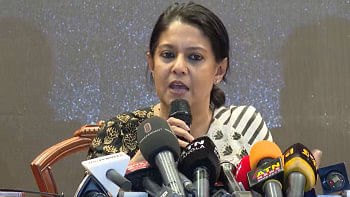ADB to help Bangladesh produce renewable energy
The Asian Development Bank is ready to partner with Bangladesh in generating clean and renewable energies, including solar, geothermal and hydropower.
Takehiko Nakao, the bank's president, lauded Bangladesh for making good strides in ensuring workplace safety following the Rana Plaza disaster and for posting an 'encouraging' 7 percent GDP growth rate.
The 50th annual meeting of the bank kicked off yesterday in the Japanese port city of Yokohama. Speaking at the inaugural press meet at the Pacifico Yokohama conference centre, Nakao explained the interrelation between ADB and China-led Asian Infrastructure Investment Bank (AIIB).
The AIIB is trying to emerge as a multilateral banking institution with a $3 billion lending portfolio, as opposed to the ADB's $31 billion.
"But the media tries to draw rivalry between the two (ADB and AIIB), whereas these are not comparable.
"When we started 50 years back, we had only 30 staff members in Manila," said the ADB president. Today, the bank has over 3,000 staffers, including 1,100 overseas employees. The AIIB is evolving with a 100-strong workforce now.
The 67-member ADB began its May 4-7 annual meet yesterday amid its golden jubilee celebrations. As many as 5,500 delegation members, representing member country finance ministers, governors, officials, NGO and civil society members and journalists gathered at the ADB Board of Governors meeting. Finance Minister AMA Muhith represented Bangladesh.
The AIIB's entry has created no competition, rather the ADB and AIIB supplement each other, said Nakao.
On why Japan is not joining AIIB, the ADB president said, "It's a matter of Japan's sovereign decision."
Twenty years after the Asian financial crisis, Nakao said the Asian countries need an estimated $1.7 trillion of yearly investment in infrastructure for the next decade or so.
The ADB president said he had nine meetings over the past three years with his AIIB counterpart, and they discussed, among other things, co-financing, staff expertise and use of local currencies in development projects.
Bangladesh boasts having the first ADB office outside its base in Manila, and is now a member of both ADB and AIIB. These two institutions already co-financed a project in Bangladesh.
On China's one belt one road (OBOR) initiative, Nakao said the bank is positive about it, but at the moment, it is working on a Central Asia Regional Connectivity (Cerec) initiative.
Looking back at ADB's operations over the last 50 years, he said Asia has become a more integrated region and weathered many a crisis in this time.
However, there still remain challenges like ensuring gender equality, further promoting the private sector, and attaining the Sustainable Development Goals.
Nakao said, after India, China gets the largest chunk of ADB loans (15 percent). At the same time, China has doubled its support to the bank's grant window Asian Development Fund (ASF) during the 2017-20 period.
The ADB president said urbanisation is not only an opportunity but also a challenge."We have to make cities more livable."
Muhith also held separate meetings with Japan International Cooperation Agency (JICA) President Shinichi Kitaoka and Bank of Japan Governor Haruhiko Kuroda at Yokohama yesterday.
Muhith later told a press meet that he assured the JICA chief of a conducive and secure environment after nearly a year of the terror attack at Dhaka's Holey Artisan Bakery.
Muhith said Japanese President Shinzō Abe had committed to give $5 billion in credit in three years, during his last visit to Bangladesh. The target is expected to be met; $1.7 billion was given through JICA for this year, added Muhith.
JICA's contribution has increased over the years, said the finance minister, adding that its contribution was $600 million three years ago.


 For all latest news, follow The Daily Star's Google News channel.
For all latest news, follow The Daily Star's Google News channel. 



Comments